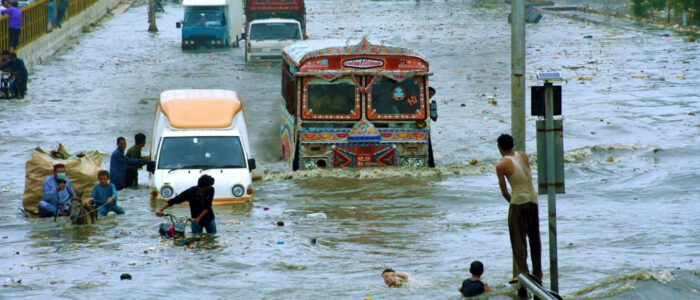Recently, the United Kingdom hosted countries from across the world for two days and held climate talks ahead of the United Nations Climate Change Conference (COP26). The summit coincided with the flooding that occurred in Islamabad, and our Federal Minister equated the planning disaster as a climatic vulnerability. By not placing the crisis under the banner of bad governance, the leaders can create an unrealistic imaginary by blurring the line between the methods of governance and climate-induced crisis.
According to the Global Climate Risk Index, the country lost roughly 10,000 people to climate-related disasters between 1998 and 2018. It sustained $4 billion in losses as a result of 152 extreme weather events during that time. According to analysts, climate migrants in Pakistan have been projected to number approximately 30 million in the last decade. Excessive urbanisation and population density alter the natural dynamics and further complicate the issue of urban flooding. Every year, monsoon rainfalls prove tragic for a major chunk, and the preparedness of the government and the relevant institutions is abysmal.
Overall, the death of a woman and her child in Islamabad is mainly due to the frail governance system. Comparison of the satellite images of 2002 – 2008 and 2010 – 2012 demonstrates the straightening of stormwater drain whilst creating a bottleneck due to the structuring of a housing authority. The housing organisation appears to have had the Capital Development Authority approve the layout plan nearly a decade ago but proceeded with plot sales and construction without getting the required no-objection certificate. Unsurprisingly, this lapse is not new and results from allowing the development of housing authorities without instituting a framework for either its planning or regulation.
By not placing the crisis under the banner of bad governance, the leaders can create an unrealistic imaginary by blurring the line between the methods of governance and climate-induced crisis.
Last year, Karachi experienced worse monsoon flooding, which left thousands of people homeless, causing an immense wreckage to the infrastructure and harvests. The authorities shut significant operations across the city as the oil pipelines were severely damaged. Housing authorities and slums have taken over storm drains that were initially intended for stormwater. The case of Gujjar and Orangi nullah sets the point. After the harrowing ordeal of monsoon rains, encroachment operations were initiated in Karachi. Notably, the encroachment drive in Gujjar nullah was not the first occurrence, and the area was cleared of encroachments in 2016. This indicates another factual evidence of the crisis as the residents belong to the lower-income strata. The government has repeatedly failed to provide subsidised facilities to the citizens falling into the lower-income group.
The validity of stormwater drains getting blocked cannot be understated, yet the crisis is of the state’s own making as the governance systems remain exclusive. The agenda of the governing bodies is not positioned vis-à-vis its citizens’ necessities. Encroachments occur because there is a severe scarcity of affordable housing for low-income residents in the city, yet the government has given no attention to this serious issue. However, it is appalling to witness that ministerial representatives cannot solely define the crisis as a challenge posed by climate change while underplaying the concept of increased urbanisation. The installation of hard, impermeable surfaces has limited the ability of the land to absorb rainfall because of urbanisation. Because less water infiltrates into the ground, the volume and rate of surface run-off increases. Arguably, in Pakistan majority of construction has occurred on the ground with a high danger of flooding, with buildings often jammed up against the riverbank. These variables make urban areas more vulnerable to river flooding, and run-off from new development can potentially worsen river flooding downstream. If the natural watercourses are not restored, the outcomes will continue to displace more people and exacerbate socio-economic conditions.
The horrors of changing climate have now become a trending topic in the policy circles, but all these given statements and promises of our leaders are not enough to curtail the unravelling disasters. The rate of deforestation in Pakistan is the second highest in Asia, and the forest cover is below 25% – the official recommended statistic. Pakistan had 33% forest cover in 1947. Because of deforestation, we only have roughly 4% of our land covered in trees now. This devastation, primarily caused by illegal logging by wood gangs, has clogged our waterways and rendered us vulnerable to flooding.
The cost of increased developmentalisation of nature is bound to challenge the well-being of our communities. The low forest cover, blocking the natural flow of water by establishing giant infrastructures, and poor urban development practices are affecting nature’s reactionary impulse. It is high time for the associated authorities to address the loopholes in their employed system of governance while working towards the practices that will reduce the climate-induced challenges. The recent episodes of urban flooding put forth the ill-preparedness of our government, if not more.
